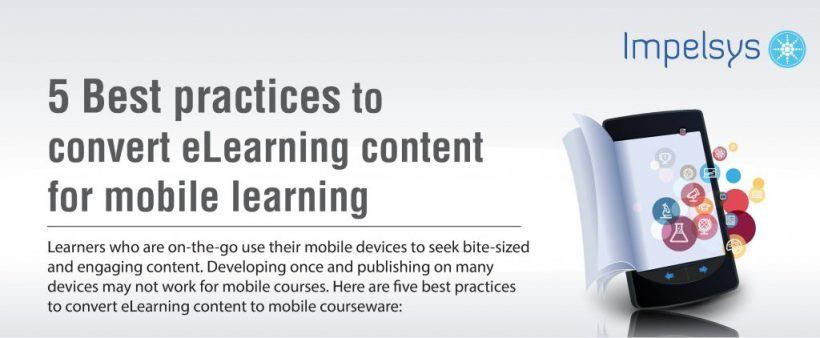How To Convert eLearning Content For Mobile Learning
Mobile learning has been revolutionizing the entire learning experience for a while now. The Pearson Student Mobile Device Survey 2015 pointed out that 85% of college students own a smartphone and 87% college students use a laptop, notebook, or Chromebook computer every week in order to do their school work. Consequently, educational institutes and schools today realize the need to make eLearning content accessible through mobile devices to enable just-in-time learning. The explosion of handheld devices has completely transformed the way students learn. Learners who are on the go use their mobile devices to seek bite-sized and engaging content. Developing once and publishing on many devices may not work for mobile courses, as it requires an explicit strategy. And using the existing eLearning course as is into a mobile format is likely to doom a mobile learning strategy. So how can instructors and schools convert existing eLearning content for mobile learning course content, and save time and money spent on creating an entirely new mobile learning course?
Here are 5 best practices for converting eLearning content for mobile learning courseware:
- Create a course outline before repurposing the content.
Before repurposing the eLearning content to make it a mobile learning course, it is advisable to create an outline of the mobile courseware. This outline must include the primary learning objectives and goals. This step will also help review existing course material and add new and relevant material to the course. Find out which eLearning elements can be effortlessly integrated into the mobile learning course and the time required for the same. Focus on key elements of content that will help achieve the learning objectives. - Integrate only the bare essentials in the mobile learning course.
It is essential for the mobile learning course content to be brief because the display screen on mobiles and tablets is smaller than a laptop or a desktop screen. It is advisable to examine the current eLearning course and use important and relevant content and images. If the course is text heavy, then it is likely to take up screen space and may not offer much value to the learners. Each element in the mobile learning course -an image or text- must have something to offer to the learner. For instance, an image in the eLearning course may have added aesthetic appeal, but it need not be included in the mobile learning course if it doesn’t add value. Keep lessons short and break the mobile learning course content to bite-sized chunks. In case topics are detailed and intricate, break the information down into easily digestible pieces that can be studied in a given time frame. This will facilitate learners to understand information quickly and rapidly absorb concepts. Use bullet points and small text blocks to deliver critical information. - Provide engaging course content.
The course content for mobile learners should be concise yet engaging and effective. High quality content is crucial for the success of a mobile learning course. Create content that leaves learners yearning for more. If the current eLearning course lacks appeal in terms of content, then revise the content when developing for mobile. - Keep navigation and interactivity simple.
Design for touch. It’s essential to keep interactivity in the mobile learning course simple. User-friendly interactivities can help engage learners. For instance, reduce the number of interactions that the learner will have to perform in a mobile learning course as opposed to lengthy interactivities in an eLearning course. Learners who are on the go may not have the time to participate in a lengthy game or simulation. Keep it straightforward. When incorporating video and audio elements, it is critical to bear in mind the learning environment. For instance, provide an option to adjust the volume or to pause a presentation when integrating multimedia elements. - Design for adaptability.
When creating the mobile learning course, ensure that it can be accessed on all platforms and devices. Responsive learning content with multi-device support ensures learners get a unique experience no matter what device. The course content should be designed in a manner that it allows to adjust the settings for multimedia elements and graphics to be re-sized to fit the page. Evaluate the mobile learning course on various mobile devices to confirm easy adaptability, ensure aesthetic appeal, and easy readability of text.
Follow these tips to convert existing eLearning content for mobile learning courses and empower learners to access learning material anytime, anywhere.








